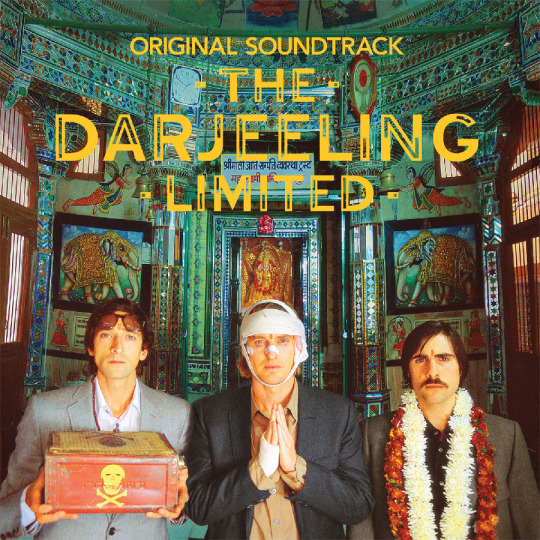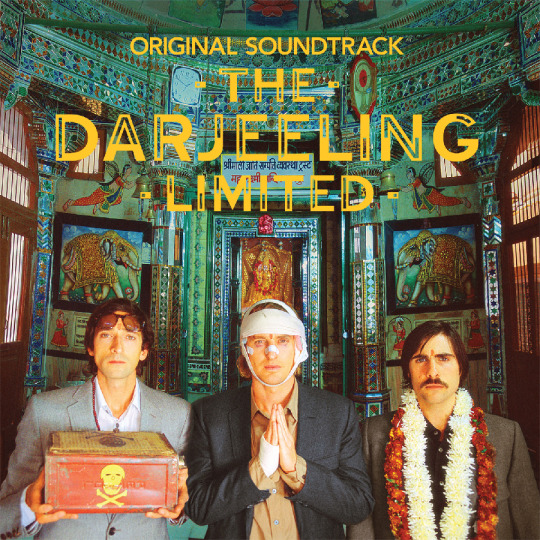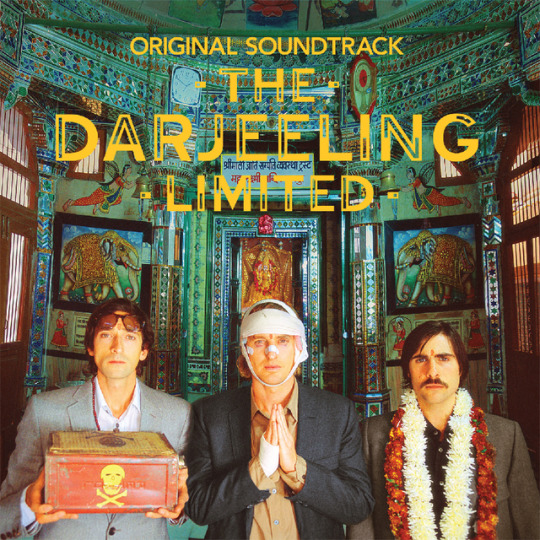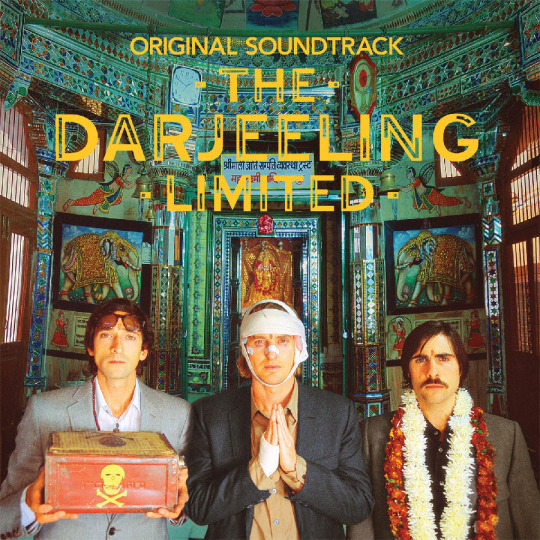#Title Music From Satyajit Ray's Film Jalsaghar
Photo

3:43 AM EST December 28, 2022:
Vilayat Khan -
""Title Music" From Satyajit Ray's Film Jalsaghar"
From the Soundtrack album The Darjeeling Limited
(September 25, 2007)
Last song scrobbled from iTunes at Last.fm
1 note
·
View note
Text
Tracing the evolution of his visible aesthetic, depiction of social issues- Leisure Information, Firstpost
http://tinyurl.com/y3wlqtec
Our photos and reminiscences of Calcutta and Bengal in the present day can be incomplete with out the work of Bimal Roy, a cameraman-turned-director, whose movies have formed and contributed to a really invaluable a part of Indian cinema. Roy’s half on this historical past is akin to the roles that Rabindranath Tagore and Satyajit Ray have performed in portraying and speaking the life, occasions and tradition of India. The event of Roy’s visible aesthetic Roy began his work in cinema as a digicam assistant to Nitin Bose within the New Theatres in Calcutta. Earlier than this, as a toddler, he had already developed a liking for drawing, portray, and taking part in the violin, and was expert within the artwork of image making. He had additionally spent a while experimenting with a field digicam offered to him by his elder brother. Bose, who might be termed Roy’s first tutor, talks about his sincerity and dedication of objective, “There was one thing in Bimal, in his light method, in his silence which impressed deep confidence. I used to be completely captivated by his attachment to work. Once we had no work, he would stand subsequent to the digicam, sprucing the lens until it sparkled. Dedication to work was one among Bimal’s biggest property.” Roy was quickly working independently as a cameraman. A number of the movies photographed by him embody these of the legendary Pramathesh C Barua, corresponding to Devdas in 1935 and Mukti in 1937. He additionally labored on some well-known documentary movies; How Kerosene Tins Are Made and Grand Trunk Street are two examples. In 1943, BN Sircar was requested by the British Authorities to doc the Bengal famine, and he selected Roy for the digicam work. The crew shot throughout Calcutta, and have been in a position to seize the “gruesomely actual” and pathetic state of the folks. Sadly, this documentary footage was by no means proven, neither is it traceable. A nonetheless from Devdas. Twitter/tweetria Udayer Pathey, filmed in Bengali in 1944, was Roy’s subsequent movie as a cameraman. Its important success took town by storm and prompted a remake in Hindi, titled Humrahi (1945). In regards to the movie, director Mrinal mentioned, “What was hanging was the outstanding approach it was shot, the extremely exact second of the digicam gave the picture of a statue within the movie, a really particular distinction.” Thus, Roy was already reaching out to folks by way of the ability and language of the photographs that he made. The Tamil movie Nalla Thangal gained Bimal Roy his first award for excellence in digicam work, following which he served because the cameraman in two extra Bengali movies, Anjangarh (1948) and Mantramugdha (1949). The spirit of his movies The spirit and persona of Roy are key components that come by way of in all of the movies that he has labored on. Particularly, Roy’s digicam was virtually all the time at eye degree, very right down to earth and reasonable. The human component was foremost in them. Roy’s household had misplaced all their ancestral zamindari or land in East Bengal and had then migrated to Calcutta. So he understood the feudal set-up and felt the heart beat of the folks throughout him – each the displaced migrants within the cities, and the impoverished villagers left behind. A few of his greatest movies are about these folks, the place his perception into their lives brings a never-seen-before realism into cinema. He walked right into a world with silent footsteps and unquestionably crammed it with the efficacy of his photos. Conscious as he was of the technological implications of behind-the-lens work, he portrayed the true reaches of social, emotional and financial devastations, small and huge by way of his command over his artwork. A nonetheless from Biraj Bahu. Twitter/FilmHistoryPic In all his movies, one also can sense that Roy stayed near his roots. The rivers of Bengal, the Baul music, the closeness to nature, the landscapes — all discover expression in his work. Most significantly, he selected the works of Sarat Chandra because the tales for a lot of of his movies. Changing into a director In 1950, Roy was invited to Bombay, the place he was given a one-film contract by Bombay Talkies to direct Maa (1952), and his distinctive under-played but shifting model of film-making made it an instantaneous success, prompting Roy to proceed to remain in Bombay, as a substitute of returning to Calcutta. By now, he had put collectively a crew of technicians for this movie, which included scriptwriter Nabendu Ghosh, assistant administrators Asit Sen and Nasir Hussein, editor Hrishikesh Mukherjee and music director Salil Chowdhury, and he continued to work with this crew additional. The 1953 movie Parineeta, primarily based on Sarat Chandra Chattopadhyay’s novel, adopted, and this was additionally one among Roy’s masterpieces. Its success led to the institution of Roy’s personal manufacturing unit, Bimal Roy Productions, now making him an impartial filmmaker. This was adopted by the discharge of his much-acclaimed breakthrough movie, Do Bhiga Zamin. It was impressed by Rabindranath Tagore’s poem of the identical title, and is predicated on the travails of a poor farmer and his experiences. Roy’s daughter Aparajita Sinha says concerning the movie’s story, “Industrialisation was consuming away on the livelihood of the agricultural farmer, a ache which he so sensitively portrays within the closing scene of Do Bigha Zameen. Within the movie, which gained an award at Cannes, Shambu loses his land to industrialisation; commerce wins and the peasant loses. The entire theme of migration of labour and the sense of displacement felt by migrants on shifting to the cities is depicted with feeling. Shambu and his household come again to the village, solely to see a manufacturing facility on their ‘do bigha zameen‘. The sense of loss is heart-rending. It was a landmark movie and until date stays a touchstone in Indian cinema.” A nonetheless from Do Bigha Zamin. Wikimedia Commons This movie was impressed by the neo-realistic movies of Italy, significantly Vittorio de Sica’s Bicycle Thieves. It was launched the yr after the primary Worldwide Movie Pageant held in India in 1952; this was one of many earliest occasions the place the movie world was uncovered to European classics by Roberto Rosellini, Vittorio De Sica and Lucino Visconti. When launched in India, the movie ran at Bombay’s Metro Theatre for under a month, regardless of the premiere being aired on radio and being compered by Sunil Dutt, who was then often called Balraj Dutt. Elementary to the formation of Roy’s filmmaking notion was his allegiance, and significantly, his ardour for Soviet cinema. He was a member of the primary Indian movie delegation to the previous Soviet Union; the publicity to socially conscious movies on the worldwide circuit etched itself into his experiences considerably. Roy recalled, “On the pageant, the Finest Image Prize was gained by the Russian movie Man’s Future, primarily based on the novel by Sholokhov. An fascinating truth which the pageant delivered to the discover of all collaborating nations was the progress made by Mongolia and Korea in filmmaking. One other notable function of the pageant was the appreciation of Indian movie music by the members of the jury in addition to the viewers. The music of Jalsaghar was unanimously voted one of the best.” Important acclaim Whereas it wasn’t a hit within the nation, Do Bigha Zamin gained industrial recognition overseas, underneath the title Two Acres Of Land and likewise turned a important milestone for Roy. He bagged awards at Cannes and the Karlovy Fluctuate Movie Festivals overseas, whereas additionally successful the Finest Movie and Finest Director awards on the inaugural Filmfare Awards in Bombay. Inspired by these successes, Roy started work on one other movie primarily based on one among Sarat Chandra’s tales, Biraj Bahu, which was additionally a success after which adopted this up with Devdas, one more of Sarat Chandra’s novels. In 1955, Roy felt that he may interpret Devdas in another way from the sooner PC Barua variations (Hindi and Bengali), each of which Roy himself had photographed 20 years earlier. The truth is, he devoted this movie to Barua and was assured that there was a brand new technology that had not learn the e-book or seen the Barua movie, who would come to see this story in a contemporary new setting and elegance. Whereas Roy efficiently gave this tragic story a brand new notion, even handpicking the solid to incorporate Dilip Kumar as Devdas, Suchitra Sen as Paro and Vyjayantimala as Chandramukhi, Devdas was nonetheless not a industrial victory. A nonetheless from Madhumati. Twitter/Bollywoodirect Two successes adopted, nevertheless: Madhumati written by Ritwik Ghatak and Yahudi in 1958. Madhumati, when seen in its entirety, had all the weather wanted to achieve success: a terrific script, Salil Chowdhury’s musical rating, and the tune ‘Aaja Re Pardesi,’ sung by Lata Mangeshkar. Depiction of ladies in Roy’s movies Roy’s subsequent two releases have been movies starring Nutan, which have been particular person hits – Sujata and Bandini. A facet pivotal to the success of the movie, each critically and commercially, was in Roy selecting Nutan to play the position, the place he recognised and was in a position to carry out the extraordinary realism in her efficiency, which was important to each roles. Bandini offers with a girl prisoner who’s pushed by life to homicide, after which she is punished however receives deliverance too, and is taken into account by many to be Roy’s most interesting and most full work. For the movie, Roy tailored Charuchandra Chakravarty’s brief story, coping with the finer nuances of the female thoughts and feminism. A nonetheless from Bandini. Twitter/karanbali Sujata, which offers with social ostracism, gained the President’s Certificates of Benefit in 1959, 5 Clare (Filmfare) Awards and an Indian entry to Cannes in 1960. Each these movies, whereas depicting the hardships of ladies, are additionally progressive and reformist of their message. The ladies in these movies had reached crises of their lives, but there’s a very liberal method to them and it’s not a judgmental view. It is a significantly spectacular presentation, as ladies within the nation have been dealing with a number of sorts of social prejudices. But Roy’s movies gave the feminine protagonist a really highly effective voice, even in her helpless state of affairs. Roy turned one of many first and few Indian filmmakers who created a separate area of interest and definitive identification for girls in cinema, thus additionally empowering ladies outdoors movies. Shaping lives Bimal Roy’s final manufacturing earlier than he died in 1966 was Benazir (1964) directed by S Khalil. The physique of labor that he has left behind is remembered most for its portrayal of the on a regular basis, non-sensational facets of life. His movies report the social, financial and ethical traits within the India of his day and age. One of many greatest legacies gifted to Indian cinema by Roy is the crew that he nurtured: Hrishikesh Mukherjee, Gulzar, Basu Bhattacharya, Salil Chaudhary, and lots of others. With Roy, and in a while their very own, these people made movies and music on very Indian themes, selected tales that questioned social norms and issues confronted by the post-independent society. Roy impressed and guided; in flip, they’ve additionally acknowledged that he formed the lives of everybody he met. A nonetheless from Pehla Admi. Twitter/NFAIOfficial Whereas talking of Do Bigha Zamin, Satyajit Ray mentioned, “It’s a movie that also reverberates within the minds of those that noticed it – and it stays one of many landmarks of Indian cinema. He was thus undoubtedly a pioneer.” Roy’s themes have been easy. Within the on a regular basis ordinariness of Indian life, he noticed the manifestation of his ideology. A definite sympathy for social, financial and non secular exploitation are themes that happen usually in Roy’s work. One can cite Roy as being instrumental in bridging the gulf between new cinema and that of the post-independence period. Probably the most important factor Roy did for Indian cinema, was to maintain it Indian. Up to date Date: Jun 15, 2019 15:32:08 IST !function(f,b,e,v,n,t,s) {if(f.fbq)return;n=f.fbq=function() {n.callMethod? n.callMethod.apply(n,arguments):n.queue.push(arguments)} ; if(!f._fbq)f._fbq=n;n.push=n;n.loaded=!0;n.version='2.0'; n.queue=[];t=b.createElement(e);t.async=!0; t.src=v;s=b.getElementsByTagName(e)[0]; s.parentNode.insertBefore(t,s)}(window,document,'script', 'https://connect.facebook.net/en_US/fbevents.js'); fbq('init', '259288058299626'); fbq('track', 'PageView'); (function(d, s, id) { var js, fjs = d.getElementsByTagName(s)[0]; if (d.getElementById(id)) return; js = d.createElement(s); js.id = id; js.src = "http://connect.facebook.net/en_GB/all.js#xfbml=1&version=v2.9&appId=1117108234997285"; fjs.parentNode.insertBefore(js, fjs); }(document, 'script', 'facebook-jssdk')); Source link
0 notes
Text
All You Need To Know About The Shehnai Maestro
Visit Now - http://zeroviral.com/all-you-need-to-know-about-the-shehnai-maestro/
All You Need To Know About The Shehnai Maestro
Shehnai maestro Bismillah Khan with his grandchildren
New Delhi: Bharat Ratna Ustad Bismillah Khan was born as Qamaruddin Khan on 21st march, 1916 in a traditional Muslim family of musicians in Bhirung Raut Ki Gali, Dumraon – in present-day Bihar. He was the second son of Paigambar Baksh Khan and Mitthan. His grandfather Rasool Baksh Khan exclaimed “Bismillah” at his birth and Qamaruddin Khan came to be known as Bismillah Khan.
Born to a family of musicians, he was trained by his uncle, the late Ali Baksh ‘Vilayatu’, who was also a shehnai player and attached to Varanasi’s Vishwanath Temple. His father was a court musician employed in the Dumrao palace by the Raja of Bhojpur. His great grandfather Ustad Salar Hussain Khan and grandfather Rasool Baksh Khan were also musicians in the Dumrao palace.
Ustab Bismillah Khan single-handedly transformed how the world looked at shehnai. From being an important folk instrument, it suddenly found a place in the heart of Indian music after Ustad Khan’s performance at Calcutta All India Music Conference in 1937.
One of the finest musicians in the world, Ustad Bismillah Khan played to audiences across the globe. Such was his devotion to his art and music that he referred to his shehnai as “begum” after the death of his wife.
The maestro was awarded India’s highest civilian honour, the Bharat Ratna, in 2001.
On the eve of India’s Independence in 1947, Bismillah khan performed at the Red Fort in Delhi. He also performed here on the eve of India’s first Republic Day ceremony in 1950. His performance soon became an integral part of the cultural programme during Independence Day celebrations in years to come. Doordarshan would regularly telecast his recital along with the Prime Minister’s address from Red Fort in Delhi.
Apart from shehnai concerts and recitals, Ustad Bismillah Khan was associated with films as well. He acted in Satyajit Ray’s much acclaimed Jalsaghar and played the shehnai in Goonj Uthi Shehnai, a 1959 film directed by Vijay Bhatt. National Award winning director Goutam Ghose directed a documentary on his life titled Sang-e-Meel Se Mulaqat. Most recently his music was incorporated in Imtiaz Ali’s Rockstar starring Ranbir Kapoor. AR Rehman, who won the Oscar for Slumdog Millionaire, was the music director of the film.
The maestro was awarded India’s highest civilian honour, the Bharat Ratna, in 2001.
Ustad Bismillah Khan’s last wish, to be able to perform at the India Gate as a tribute to the martyrs, remained unfulfilled after he suffered a fatal cardiac arrest.
A day of national mourning was declared by the government on his death. He was buried along with his shehnai under a neem tree at Fatemaan burial ground in old Varanasi with a 21-gun salute from the Indian Army.
The Sangeet Natak Akademi, New Delhi, instituted the Ustad Bismillah Khan Yuva Puraskar in 2007, in his honour, which is conferred to young artists in the field of music, theatre and dance.
On his 102nd birth anniversary, Google paid tribute to the musician with a doodle. His music will remain till the end of time, the way he had famously prophesied, “Even if the world ends, the music will still survive.”
0 notes
Photo

10:28 AM EDT June 9, 2022:
Vilayat Khan -
""Title Music" From Satyajit Ray's Film Jalsaghar"
From the Soundtrack album The Darjeeling Limited
(September 25, 2007)
Last song scrobbled from iTunes at Last.fm
0 notes
Photo

1:19 AM EDT October 27, 2021:
Vilayat Khan -
""Title Music" From Satyajit Ray's Film Jalsaghar"
From the Soundtrack album The Darjeeling Limited
(September 25, 2007)
Last song scrobbled from iTunes at Last.fm
6 notes
·
View notes
Photo

8:18 PM EST February 17, 2019:
Vilayat Khan -
""Title Music" From Satyajit Ray's Film Jalsaghar\"
From the Soundtrack album The Darjeeling Limited
(September 25, 2007)
Last song scrobbled from iTunes at Last\.fm
1 note
·
View note
Photo

8:05 PM EST March 17, 2022:
Vilayat Khan -
""Title Music" From Satyajit Ray's Film Jalsaghar"
From the Soundtrack album The Darjeeling Limited
(September 25, 2007)
Last song scrobbled from iTunes at Last.fm
1 note
·
View note